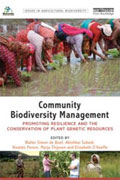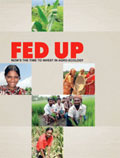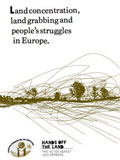Community biodiversity management / Fed up / Land concentration, land grabbing and people’s struggles in Europe / Our nutrient world / State of the World 2013 / The Committee on World Food Security (CFS) / More on markets
Community biodiversity management: Promoting resilience and the conservation of plant genetic resources

How to conserve agro-biodiversity in practice? Simply promoting different varieties has not worked. This book presents experiences from different organisations that support farmers through community biodiversity management (CBM). This methodology is based on the premise that farmers have their own ideas and priorities when it comes to agricultural development and the use of plant varieties.
Conservation measures and plant varieties are put in the context of livelihood development rather than making them the primary goal. The book starts with the history of CBM and goes on to describe experiences of CBM practices including diversity fairs and community seed banks. The final part summarises the lessons learnt from these experiences and discusses their implications for community resilience.
Fed up: Now’s the time to invest in agroecology

Agricultural and food systems are failing and agro-ecology can play an important role in fixing them. That is the message of this publication in a nutshell. Drawing on a number of studies the author shows how climate change, biodiversity loss, natural resource degradation, urbanisation, hunger, obesity and excessive food waste are threatening the health of existing social and ecological systems.
A strong, empirically grounded case, drawing on examples from Pakistan, Bangladesh, Indonesia and Cambodia, is made for agro-ecology as the way forward. The report shows how agroecology can increase yields, improve food and nutrition security, reduce rural poverty, build community and climate resilience and empower small scale producers.
Land concentration, land grabbing and people’s struggles in Europe

When it comes to land grabbing most people think of the global South. This publication challenges this view. In the EU, 3% of the largest farms control 50% of all farm land. Moreover, land concentration is accelerating and subsidies paid under Europe’s Common Agricultural Policy stimulate this.
In Spain, for example, 16% of the largest farmers receive 75% of all subsidies. In addition to land concentration, this report also examines cases of land grabbing in Europe: by Chinese companies in Bulgaria, Middle Eastern companies in Romania, and European companies elsewhere in the EU. The articles also show how new movements are emerging that are both resisting these land grabs and concentration, or arguing for alternatives.
Our nutrient world: The challenge to produce more food and energy with less pollution
The Global Partnership on Nutrient Management and the International Nitrogen Initiative, 2013. Centre for Ecology and Hydrology, Edinburgh. 115 pages.
Ever wondered what the world food problem looks like from the perspective of nutrients? If so, this publication offers some interesting insights. A major problem is the loss of nutrients; 80% of nitrogen and between 25 and 75% of the phosphorus consumed is lost to the environment. The results include a deterioration of water quality, air pollution, greenhouse gas emissions, the loss of ecosystems and biodiversity and the acidification of soils. Another problem is a shortage of nutrients which can lead to land degradation. The authors propose several solutions, including improving nutrient efficiency in crop and animal production, reducing food waste, recycling nutrients from waste water systems and lowering the personal meat consumption.
State of the World 2013: Is sustainability still possible?
Book cover: State of the World 2013: Is sustainability still possible?The World Watch Institute, 2013. Island Press, Washington. 464 pages.
“We live today in an age of sustainababble, a cacophonous profusion of uses of the word sustainable to mean anything from environmentally better to cool”. Sustainability, continues Robert Engelman, author of the introductory chapter and president of the World Watch Institute, has become a marketing catchphrase for practices or products that are at best slightly less damaging than the conventional alternatives.
In this latest edition of the State of the World series, scientists and policy experts attempt to restore the meaning of sustainability. What definition do we need to work from? What needs to be done to move towards true sustainability? And how to prepare for the possibility of a global environmental catastrophe?
The Committee on World Food Security (CFS): A new space for the food policies of the world, opportunities and limitations
La Via Campesina, 2012. La Via Campesina, Jakarta. 15 pages.
The 2009 reform of the United Nations Committee on World Food Security (CFS) opened a space for civil society organisations in the global policy arena. This 4th edition of La Via Campesina’s Notebook reflects on some of the sessions that have taken place since the reform and analyses the impact La Via Campesina and other civil society organisations have had within the CFS.
The central questions are whether and to what extent the CFS provides a vehicle for promoting the concerns of grassroots and social movements. The report ends by discussing one of the dilemmas faced by La Via Campesina: does investing so much energy on institutional work have a detrimental effect on mobilisation and the struggles on the ground?
More on markets
Most resources on smallholders and markets deal with commodity markets. Both “Small producer agency in the globalised market: Making choices in a changing world” (B. Vorley et al., 2012) and “Value chains, social inclusion and economic development: Contrasting theories and realities” (A.H.J. Helmsing and S. Vellema, eds., 2011) explore the relationship between value chains and small scale farmers.
“Organic supply chains for small farmer income generation in developing countries: Case studies in India, Thailand, Brazil, Hungary and Africa” (W. Edwardson and P. Santacoloma, 2013) looks at the opportunities for smallholder farmers in the growing market for organic certified products. “Learning and earning: How a value chain learning alliance strengthens farmer entrpreneurship in Ethiopia” (J. Belt and W. Goris, 2011) describes an approach through which smallholder farmers gained the necessary skills to produce for the commercial market. Interestingly, there is also a growing body of literature on alternative food markets.
In “Rural development through the construction of new, nested, markets: Comparative perspectives from China, Brazil and the European Union” (J.D. van der Ploeg et al., 2012) and in “On governance, embedding and marketing: Reflections on the construction of alternative sustainable food networks (D. Roep and J.S.C. Wiskerke), the emergence and dynamics of these markets are explored.
A special, policy driven market is described in “The Food Acquisition Program in Brazil: Contributions to biodiversity, food security and nutrition” (C. Grisa and C. Schmitt, 2013).

